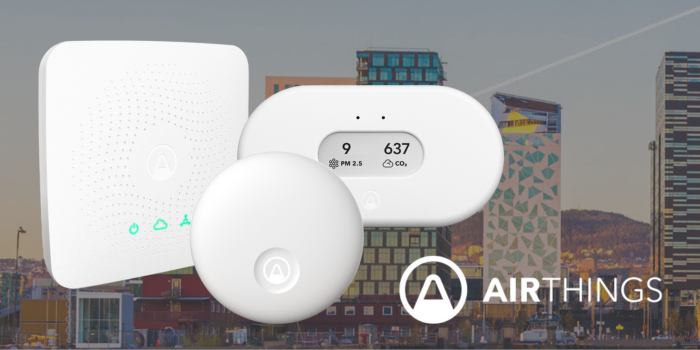Indoor air quality is often up to five times worse than outside. Considering most people spend 90% of their time inside, it’s time for a smarter solution.
Why is Indoor Air Quality Important?
People spend a lot of time indoors, so it’s no surprise that Indoor Air Quality (IAQ) is strongly and directly connected to health and well-being. According to the US Environment Protection Agency, indoor air pollution is one of the top five environmental risks to public health. Annually, 3.8 million people worldwide prematurely die from illnesses attributable to indoor air pollution.
Poor indoor air quality can cause short-term issues, like headaches, inflammation of the nose, throat and eyes, and flare-ups of pneumonia or bronchitis, or it can contribute to long-term problems like cardiovascular diseases and lung cancer. It has also been associated with aggravating respiratory issues, including asthma.
Improving indoor air quality is one of the most important steps you can take to ensure good health and optimal comfort.
What Causes Poor Indoor Air Quality?
Indoor air quality largely comes down to several key contaminants and components, which are known to play a role in comfort and health.
Pollutants that can affect the air quality inside buildings fall into one or more of the following categories:
Particulate Matter (PM):
Particulate matter is a range of dust, dirt, and liquid particles that become suspended in the air. This includes dust, smoke and tobacco smoke, pollen, animal dander, particles generated from combustion appliances, and particles associated with dust mites, mold, and bacteria.
Some are large enough to see, like smoke, smog, or soot. The healthier the air, the fewer PMs.
Airborne Chemicals/Volatile Organic Compounds (VOCs):
Airborne chemicals/Volatile Organic Compounds (VOCs) come from combustion processes such as solid fuel heating, gas cooking stoves, vehicle exhaust, and tobacco smoke. They can also come from building materials, furnishings, adhesives, paint, varnish, cleaning products, and pesticides.
Carbon Dioxide (CO2):
Emitted naturally by breathing, CO2 can build up in poorly ventilated buildings where the air is recycled. High concentrations are linked to poor decision-making, low productivity, and infectious disease transmission.
Environmental Pollution & Radon:
Environmental pollution indoors comes from outside contaminants like vehicle fumes and industrial pollution that can seep into buildings. It can also come from naturally occurring gases like radon. Radon is a naturally occurring radioactive gas that seeps into buildings from rocks and soil and can build up to dangerous levels indoors.
Human Contamination/Virus Risk:
People in buildings are often carriers of viruses that can spread through the air.
Improved indoor air quality can help stop the risk of airborne viruses, including SARS-COV-2, the virus that causes COVID-19 (coronavirus), and other viruses. The Biden-Harris Administration identified improved indoor air quality as an important tool to fight the spread of airborne diseases in the American Pandemic Preparedness Plan in September 2021, and the National COVID-19 Preparedness Plan prioritized it again in March 2022.
SMACNA Prioritizes IAQ
Recently, SMACNA launched WeAreWhatWeBreathe.com, a new web resource designed to raise public awareness for indoor air pollution and how indoor air quality (IAQ) improvements can help improve occupants’ health. This comprehensive site is a destination for private and public stakeholders to explore how ventilation, airflow, and indoor air quality impact schools, homes, and office settings.
“The pandemic shined a much-needed light on indoor air quality and some of the major health concerns arising in our schools, homes, and workplaces,” SMACNA Chief Executive Officer Aaron Hilger said. “As a standard-setting organization, SMACNA is proud to play a leading role in addressing the impact of poor ventilation and air quality on our lives. We hope this website will be a helpful resource while instilling a sense of urgency for building owners and school systems to provide tenants with the clean, quality air they deserve.”
To learn more about indoor air pollutants and the need for better ventilation, visit WeAreWhatWeBreathe.com.
The Solution: Airthings for Business
Like other environmental health risks, IAQ can easily and reliably be monitored to assess risks and improve air quality. Airthings provides the complete solution to improving the health and well-being of your building and its occupants.
Ductmate now offers the Airthings Space Hub, Space Pro, Space Plus, Space Nano, and Space CO2 Mini devices to building owners to help map out issues within their facilities and target the root causes of poor air quality and energy inefficiency in their buildings. These three products can be configured to meet the needs of virtually any small to medium-sized commercial or institutional structure, including schools, offices, hospitals, and more.
Depending on the product, Airthings devices monitor particulate matter (PM), carbon dioxide (CO2), airborne chemicals (VOCs), temperature, and more, as well as its virtual sensors that monitor occupancy and virus risk. When paired with the Airthings dashboard, you can monitor data remotely in real time and make smarter decisions to improve your indoor air quality and energy efficiency levels.
Why suffer through poor indoor air quality that can adversely affect your health when there’s a simple solution? And when it comes to energy bills, why pay more than you have to? On average, an Airthings for Business customer saves up to 20% on energy costs.
Where Can I Buy Airthings?
Ready to buy Airthings? To purchase the Airthings for Business solution, please contact Ductmate customer service at 1 (800) 990-8459.
